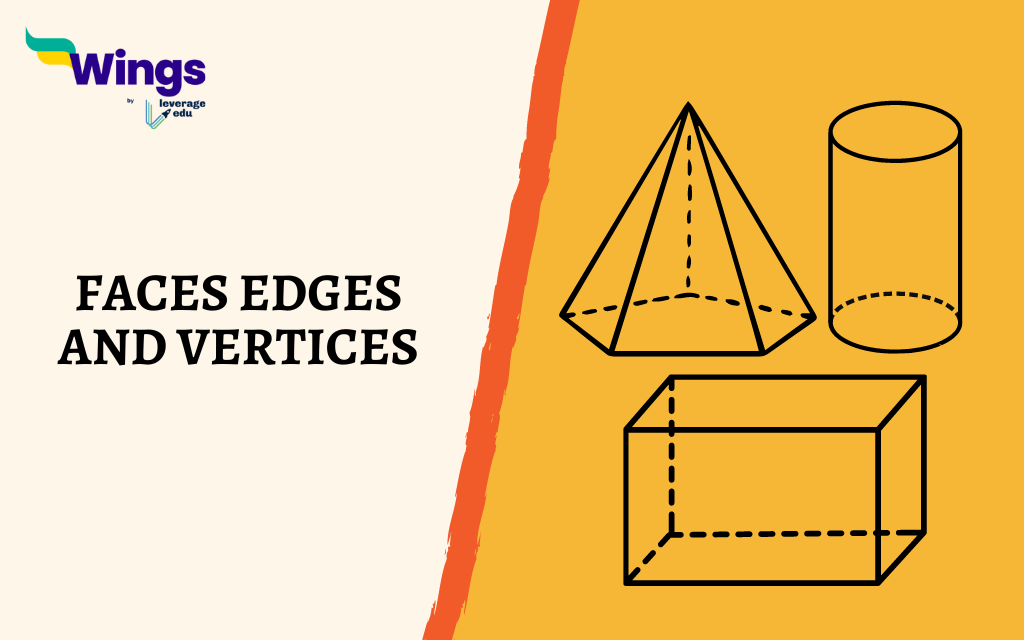Any three-dimensional solid can be defined by its vertices, faces, and edges. These are the three properties that define a solid. Faces are flat surfaces, and edges are straight lines that connect two faces. A vertex is the corner of the shape, while a face is a flat surface. Each face, edge, and vertex of a three-dimensional shape is distinct from the others.
In our everyday lives, we come across a plethora of objects of different shapes and sizes. For instance, basketballs, doormats, coffee mugs and so on These objects are considered to have different distinctive properties such as length, breadth, diameter, etc., which differentiate them from each other.
Even though they all might have different dimensions, they all occupy space and have three dimensions, which makes them three-dimensional shapes or solids.
Let us get a better understanding of how a three-dimensional shape or an object is constructed by combining many different components. There are polygonal regions that make up the majority of the solid figures. There are three types of regions: faces, edges, and vertices. The names given to solid geometric shapes with faces, edges, and vertices are polyhedrons.
Vertices
In the same way that a corner is the point at which two or more line segments or edges meet, a vertex is the point at which a shape is formed. The points that are located at the corners of a shape are referred to as vertices. The term “vertex” refers to the singular form of the term “vertices.” If we take a cube as an example, we can see that it has eight vertices, whereas a cone only has one. On the other hand, shapes such as cylinders and spheres do not have a vertex.
The arrow in the image above serves as a visual representation of what a cube’s vertex looks like.
Faces
One way to define faces is as the flat surface of a solid shape. Faces can also be referred to as the outer surface of a solid object, regardless of whether the face is straight or curved.
While it is true that our reality is three dimensional, it is also crucial to be aware that because three dimensional shapes are all around us, it is physically impossible to manipulate two-dimensional shapes.
The number of faces that an object possesses varies from one object to another. For example, cubes and cuboids have six faces; cones have two flat faces and one curved face; cylinders have two flat faces and one curved face; and spheres have only one curved face.
The arrow in the image above serves as a visual representation of what a cube’s face looks like.
Edges
An edge can be defined as the line segment where the faces of a solid meet. Even though many shapes have straight edges and lines, some shapes, like hemispheres, have curved edges.
Just like different objects have different faces and vertices, the different objects also have different edges, like cube and cuboids, which have 12 edges, cones have a single edge, cylinders have 2 edges; and spheres have no edge
.
The arrow in the image above serves as a visual representation of what a cube’s edge looks like.
Vertices, Faces and Edges of 3D Shapes
With the use of a table, let us compare the vertices, faces, and edges of solid forms.
| Solid Name | Vertices | Faces | Edges |
|---|---|---|---|
| Cube | 8 | 6 (square faces) | 12 |
| Cuboid | 8 | 6 (rectangular faces) | 12 |
| Cone | 1 | 2 | 1 |
| Cylinder | 0 | 3 | 2 |
| Sphere | 0 | 1 | 0 |
The Euler’s Formula
Euler’s Formula may help us understand the connection between vertices, faces, and edges.
Keep in mind that the formula applies to closed solids with flat sides and straight edges, such as cuboids. It cannot be used with cylinders since their edges are curved.
The Euler Formula is as follows:
F+V-E = 2
Where F, V, and E are the number of faces, vertices, and edges of the polyhedra, respectively.
FAQs
Three-dimensional solids are objects that occupy space and have three dimensions: length, width, and height. They can be defined by their vertices, faces, and edges.
Vertices: Points where edges meet, forming the corners of a shape.
Faces: Flat surfaces that make up the outer boundary of a solid object.
Edges: Line segments where faces of a solid meet
Euler’s Formula states that for any closed polyhedron with flat sides and straight edges, the number of faces (F), vertices (V), and edges (E) are related by the equation: F + V – E = 2.
I hope this helps! Did you like learning about the faces, edges and vertices of a shape? If yes, you would surely like to read on the perimeter of rectangle!
 One app for all your study abroad needs
One app for all your study abroad needs














